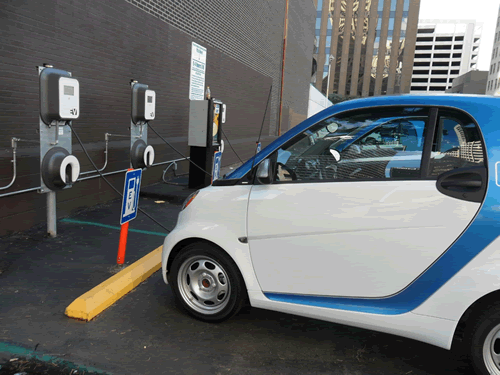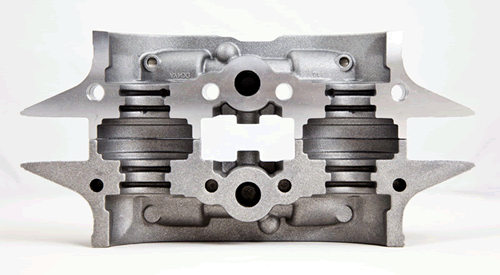Cold-Formed Connectors Boost Electric Vehicles
Power connectors have wide application in the growing electric vehicle market. Producing them via cold forming could deliver multiple benefits, including enhanced part quality and less metal waste.
 Tighter regulations on CO2 emissions mean that even Formula 1 cars must now be more fuel-efficient – proof, if it were needed, of the inexorable rise of sustainability in the automotive industry.
Tighter regulations on CO2 emissions mean that even Formula 1 cars must now be more fuel-efficient – proof, if it were needed, of the inexorable rise of sustainability in the automotive industry.
Away from the racetrack, increased fuel efficiency is helping to cut emissions, but there also has been significant progress in the number of electric vehicles on the road.
Manufacturers such as BMW and Nissan have proved the viability of electric vehicles. The Nissan LEAF became the best-selling electric vehicle in history in 2014, with sales topping 100,000. According to the Society of Motor Manufacturers and Traders (SMMT), electric vehicle registrations in 2014 reached nearly 1.3 million, a rise of 10% over the previous year.
Since the number of pure electric vehicle models in SMMT’s registration database is now into double figures, perhaps the most striking statistic is presented in its table of the top 10 lowest CO2-emitting models. As all pure electric vehicles offer zero tailpipe emissions, the top spot is shared by 11 vehicles. And while such models continue to expand in numbers, no vehicle that is not purely electric has any hope of ever again entering the top 10.

As the topic of environmental sustainability becomes more important, electric vehicles are growing in popularity.
Engineering Challenge
While electric transport brings hope for enhanced sustainability, it also sets engineering challenges – as each advance in one stage of the power transmission chain requires others to match it. The best lithium-ion battery, for example, which uses metal oxides in the positive electrode, cannot provide much more than 100 miles of service. This is not a viable solution for widespread adoption. Then there is the issue of charging stations to consider: As plug-in electric vehicle ownership expands, so does the need for charging stations – with fast-charging capabilities. In addition to on-street facilities provided by electric utility companies, mobile charging stations provide a range of special connectors to accommodate a variety of vehicles.
According to Richard Martin, editorial director for clean technology marketing at consultant firm Navigant Research, “fast charging, however and whenever it gets built, is going to be key for the development of a mainstream market for plug-in electric vehicles.”
Enhancements to even the smallest components are required to establish the electric car as a serious player. The need for enhanced sustainability – coupled with the potential commercial reward for making a significant advance in the field – makes it likely that existing engineering hurdles will be circumvented in some way.
Powertrain Innovations
Optimizing powertrain efficiency will increase electric vehicle mileage and reduce energy consumption while maintaining performance levels. There has been considerable innovation in this field. For example, electric vehicle motors are engineered to run at very high speeds, in order to increase efficiency and power density. In turn, this means that components such as bearings must be engineered to minimize friction while operating for much longer periods. To this end, bearings have been designed with features such as optimized internal geometry, making them extremely robust and energy-efficient at sustained high speeds. Innovations such as this help electric vehicle manufacturers to offer increased mileage and improve the robustness of the powertrain’s key components.
Similarly, recent advances in power connector technology have enabled designers to boost power conversion from motors and powertrains. Power connectors are used in electric vehicles for charging units and in the motors used to drive each wheel. Manufacturers are striving to improve the efficiency of power connectors to minimize power losses while reducing weight and cost. One option is to engineer connectors using precision cold forming, which enhances part quality and significantly cuts metal waste.
Cold Comfort
Precision cold forming can produce precision-engineered parts with up to 80% less scrap than other machining processes. Coupled with faster lead times, better surface finish, and improved mechanical characteristics, it offers manufacturers a way to enhance component quality while reducing costs.
Performed at ambient temperatures, cold forming is a faster process than many competing techniques. Components can be made to order extremely quickly, which cuts lead times and removes the need to store high volumes of spare parts onsite. Aside from tangible cost savings, cold forming results in superior quality products: It plasticizes metals along their grain boundaries rather than cutting across, producing parts with low stress deformation and high levels of mechanical integrity – for greater performance and reliability.
Furthermore, cold forming offers high levels of definition, even on parts with complex contours. Dimensional tolerances can be to within five microns, with the added benefit of extremely fine surface finishes, which in many cases require no further machining or polishing.
At the same time, parts undergo work hardening during cold forming, further improving their machinability and durability. Work hardening reforms the structure of the metal to prevent further dislocations, resulting in a stronger component. As this strength increase is comparable to that of heat treating, it can be more cost-effective to cold work a weaker, less costly metal than to hot work a more expensive one, particularly when a precision finish is required.
Cold forming can also produce component parts with a superior finish, both on the surface and internally. Accurate internal profiles and complex external profiles can be made, enabling the manufacture of precision parts. This can have a significant impact on the performance of the equipment in which they are used. Furthermore, there is almost no limit to the shape, size, or complexity of the metal components that can be produced – from simple to highly complex, for a diversity of applications.

Specialist components are precision-engineered for automotive applications.
[hr]
Mark Jennings is the engineering director of Dawson Shanahan.





